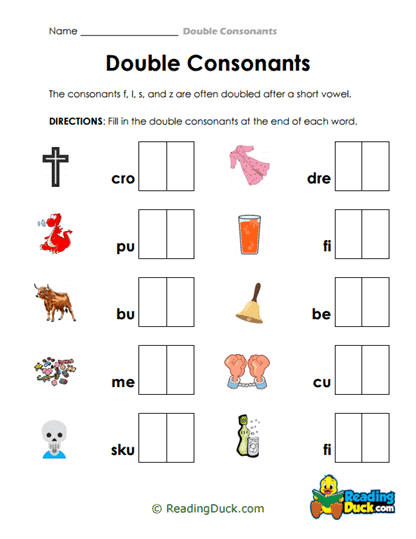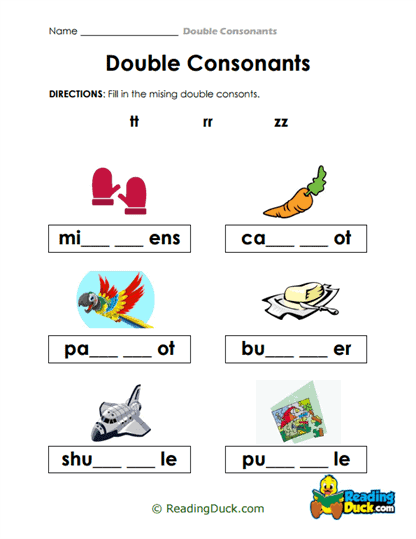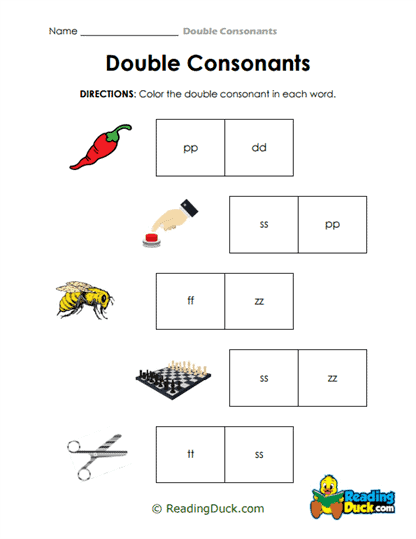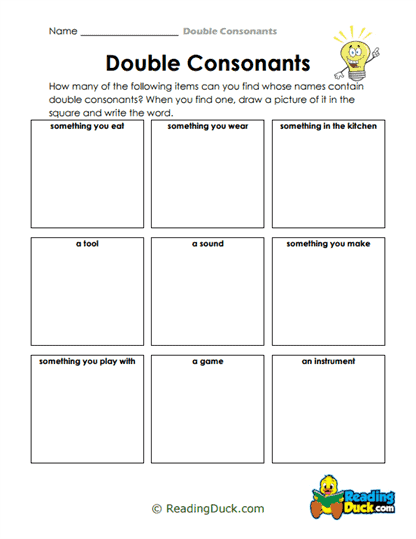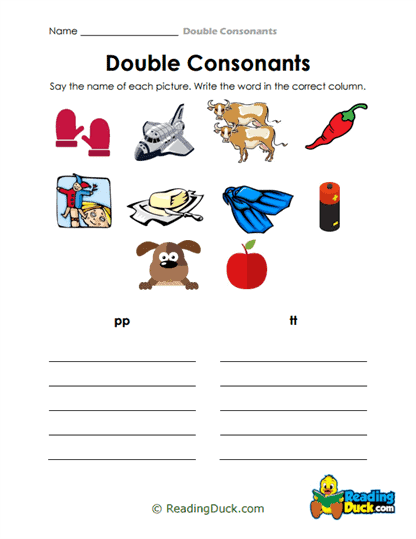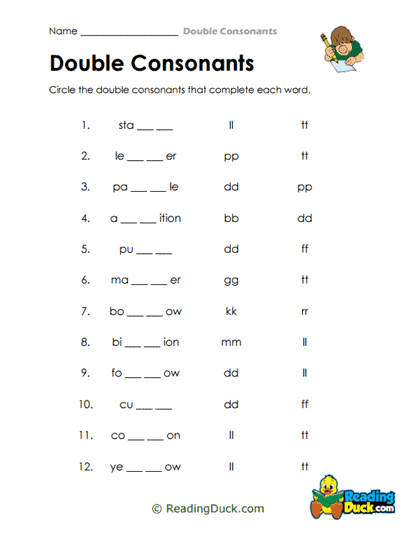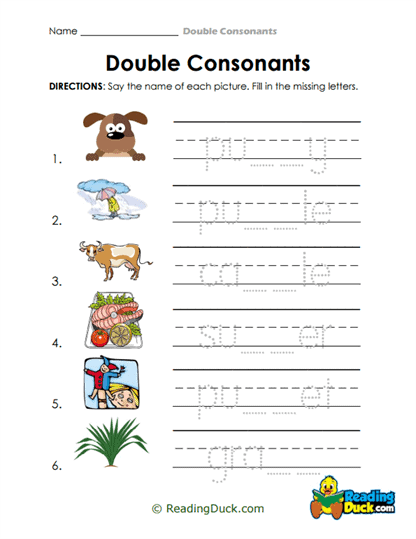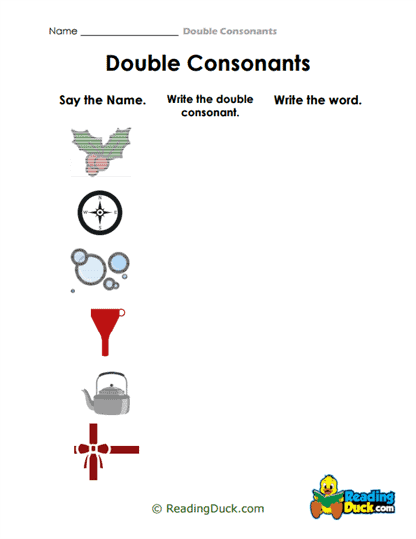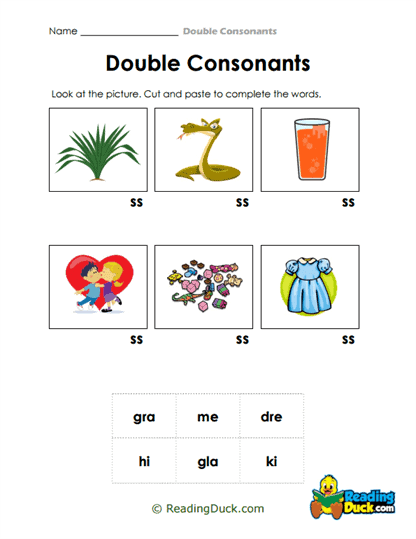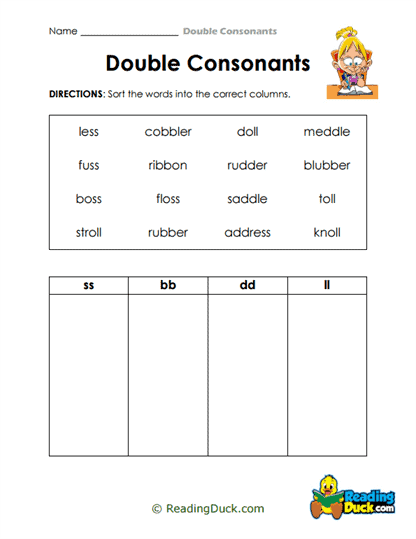Double Consonant Worksheets
About Our Double Consonant Worksheets
Our collection of Double Consonant Worksheets is an essential resource within the 'Phonics' category of the 'Pre-Reading' section, specifically designed to help young learners understand and master the concept of double consonants. These worksheets focus on teaching students how to recognize, pronounce, and spell words with double consonants, which is a critical step in their early reading development.
Available in a convenient PDF format, these worksheets are easy to view, download, and print, making them ideal for both classroom and homeschool environments. Each worksheet also includes a downloadable answer key, allowing educators and parents to efficiently guide students through the learning process and accurately assess their progress.
Understanding Double Consonants and Their Importance in Early Literacy Development
Double consonants play a crucial role in early literacy, helping young learners with word recognition, pronunciation, and spelling. As a professional licensed teacher specializing in pre-reading skills, it's important to explore what double consonants are, why they are significant, and how they contribute to a child's overall literacy development.
What Are Double Consonants?
- Definition: Double consonants occur when a consonant is repeated in a word, typically at the junction of a root word and a suffix or in the middle of a word. Common examples include "ll" in "bell," "ss" in "grass," and "pp" in "puppy."
- Spelling Rules: Double consonants often appear in words when adding suffixes such as -ed, -ing, or -er to a base word that ends in a single vowel followed by a consonant. For example, "hop" becomes "hopping," and "big" becomes "bigger." The consonant is doubled to preserve the short vowel sound in the root word.
Importance of Double Consonants in Early Reading Development:
- Phonemic Awareness: Understanding double consonants is vital for developing phonemic awareness, which is the ability to recognize and manipulate the individual sounds in words. Double consonants help young learners understand how sounds and letters interact in English spelling.
- Pronunciation and Fluency: Recognizing double consonants aids in proper pronunciation. In words like "silly" or "butter," the double consonant affects how the word is pronounced, usually indicating a shorter vowel sound before the doubled letter. This understanding contributes to improved reading fluency.
- Spelling Accuracy: Learning the rules of double consonants helps students spell words correctly, particularly when adding suffixes. This is essential for writing proficiency and for avoiding common spelling mistakes.
- Word Recognition: Double consonants are a common feature in many English words. Familiarity with this concept enhances a child's ability to recognize and read a wider range of words accurately and confidently.
Examples of Double Consonants and Their Impact on Learning:
- "Running": In the word "running," the "n" is doubled to maintain the short vowel sound in "run" before adding the -ing suffix. Recognizing this pattern helps students apply the rule to other similar words, such as "jogging" or "fitting."
- "Happy": In "happy," the double "p" affects both pronunciation and spelling. Understanding why the "p" is doubled helps children spell similar words like "puppy" or "sloppy" correctly.
How These Worksheets Support the Learning and Practice of Double Consonants
Our Double Consonant Worksheets are designed to help young learners recognize, understand, and practice the use of double consonants in a systematic and engaging way.
Structured Phonics Instruction:
- Gradual Introduction: The worksheets introduce the concept of double consonants gradually, starting with simple examples and progressing to more complex applications. This allows students to build their understanding step by step without feeling overwhelmed.
- Reinforcement of Spelling Rules: Through consistent practice, these worksheets reinforce the spelling rules associated with double consonants, helping students internalize these patterns. This reinforcement is crucial for ensuring that students can apply these rules independently in their reading and writing.
- Encouraging Decoding Skills: The worksheets provide opportunities for students to decode words with double consonants, strengthening their ability to sound out and read new words accurately. Decoding practice is essential for developing reading fluency and confidence.
Supporting Independent Learning:
- Self-Paced Practice: The worksheets are designed for independent use, allowing students to work at their own pace. This flexibility is beneficial in both classroom and homeschool settings, where students may have different levels of proficiency with double consonants.
- Visual and Auditory Reinforcement: By incorporating visual cues, such as color-coded letters or pictures, the worksheets help students associate double consonants with specific sounds. This visual reinforcement, combined with auditory practice, caters to different learning styles and enhances comprehension.
Strategies for Teaching Double Consonants Effectively
Teaching double consonants requires a systematic approach to ensure that young learners grasp the concept and can apply it confidently in their reading and writing. Here are some strategies that educators can use to introduce and teach double consonants effectively:
Introducing Double Consonants:
- Start with Familiar Words: Begin by introducing double consonants using familiar words that students may already know, such as "happy," "little," or "puppy." This provides a foundation that makes it easier for students to understand the concept.
- Use Visual Aids: Incorporate visual aids, such as charts, flashcards, or digital presentations, that highlight the double consonants in words. Visuals help students see the repeated consonant and understand its role in the word.
- Modeling and Guided Practice: Demonstrate how to read and spell words with double consonants by breaking down the word into its individual sounds. For example, explain how "hop" becomes "hopping" and why the "p" is doubled. Guided practice with the class or in small groups reinforces the concept.
Helping Students Master Double Consonants:
- Interactive Reading: Include books or passages that contain words with double consonants in your reading sessions. Pause to highlight these words and discuss the double consonants with students, reinforcing their understanding in context.
- Consistent Practice: Ensure that students have ample opportunities to practice reading and writing words with double consonants. Repetition is key to mastery, so integrate these words into daily phonics lessons and spelling activities.
- Word Exploration: Encourage students to find and share examples of words with double consonants in their reading materials. This exploration not only reinforces their understanding but also builds their confidence in applying phonics rules independently.
Practical Tips for Using Double Consonant Worksheets Effectively
To maximize the benefits of the Double Consonant Worksheets, educators and parents can implement the following practical tips, ensuring that young learners fully grasp the concept and apply it confidently.
Incorporating Worksheets into Daily Practice:
- Morning Literacy Warm-Ups: Use the worksheets as part of a morning literacy warm-up. This routine practice helps reinforce double consonant patterns and prepares students for the day's reading and writing activities.
- Homework Assignments: Assign worksheets as homework to provide additional practice. Encourage parents to review double consonant words with their children, reinforcing what was taught in class.
- Small Group Instruction: Use the worksheets during small group instruction to provide targeted phonics practice. This setting allows for personalized guidance and the opportunity to address any challenges students might face with double consonants.
Supplementary Activities to Reinforce Learning:
- Word Sorting: Create a word-sorting activity where students categorize words based on whether they contain double consonants. This activity helps them see the differences between various word patterns and reinforces their understanding of spelling rules.
- Interactive Games: Incorporate phonics games that focus on double consonants, such as bingo or matching games. These activities make learning fun and engaging while providing additional practice with the concept.
- Creative Writing: Encourage students to write sentences or short stories using words with double consonants. This activity not only reinforces the phonics patterns but also enhances their writing skills and creativity.
Empowering Young Learners with Double Consonant Worksheets
In conclusion, our Double Consonant Worksheets within the 'Phonics' category of the 'Pre-Reading' section are an essential resource for helping young learners develop strong phonics skills, particularly in recognizing and applying double consonants in their reading and writing. By focusing on this concept, these worksheets provide children with the tools they need to advance from simple word recognition to more complex literacy skills.
These worksheets are not just about learning a spelling rule; they are about empowering children to become confident, capable readers and writers. As they master double consonants, students will find themselves better equipped to tackle a broader range of texts, enhancing both their reading fluency and spelling accuracy.
Educators and parents can use these worksheets to create a supportive learning environment that encourages both independent practice and guided instruction. Through consistent use, supplemented with engaging activities and real-world applications, students will develop a strong foundation in phonics that will serve them well as they continue their literacy journey.
Perfect for kindergarten through second-grade learners, these worksheets are an invaluable addition to any early literacy program. They ensure that young readers gain the skills and confidence they need to succeed, both in the classroom and beyond.
